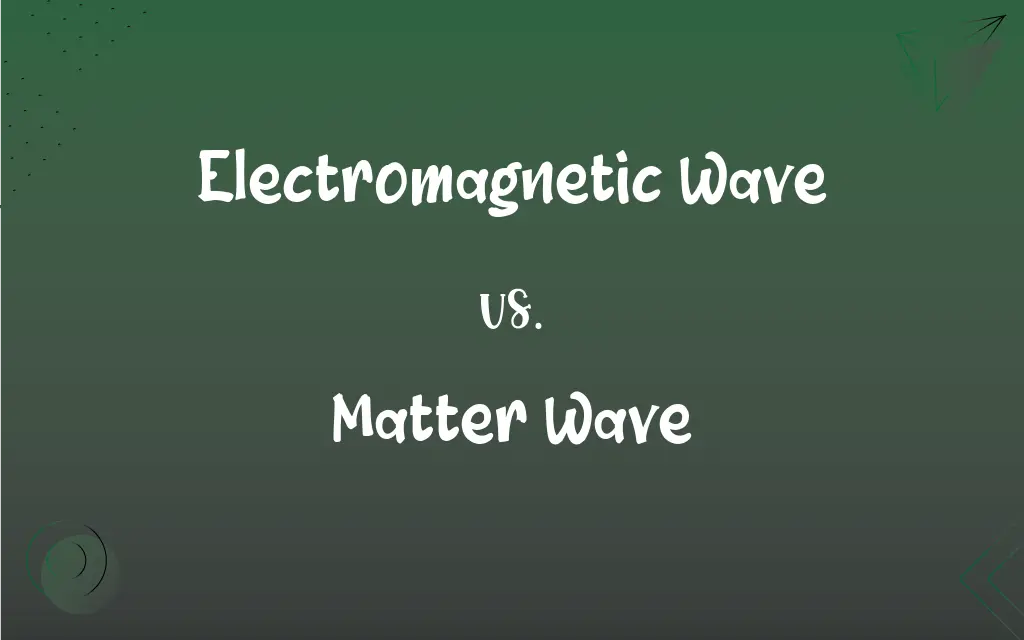Electromagnetic Wave vs. Matter Wave: What's the Difference?
Edited by Aimie Carlson || By Harlon Moss || Published on January 14, 2024
Electromagnetic Wave refers to waves of oscillating electric and magnetic fields, like light. Matter Wave refers to wave properties of particles, as described by quantum mechanics.

Key Differences
Electromagnetic waves are oscillations of electric and magnetic fields that propagate through space, key to understanding classical physics. They include a wide spectrum, from radio waves to gamma rays. Matter waves, on the other hand, are a concept from quantum mechanics, describing the wave-like properties of particles, like electrons.
Electromagnetic waves travel at the speed of light in a vacuum and do not require a medium. They demonstrate phenomena like reflection and refraction. In contrast, matter waves are associated with particles and have a wavelength inversely proportional to their momentum, as described by the de Broglie hypothesis.
The concept of electromagnetic waves arises from Maxwell's equations and is fundamental in fields like optics and telecommunications. These waves can be polarized. Matter waves, embodying wave-particle duality, are central to quantum mechanics, crucial for understanding phenomena at atomic and subatomic scales.
In electromagnetic waves, energy is transferred through the oscillation of electric and magnetic fields. They are responsible for phenomena like radio transmission and visible light. Matter waves reflect the probabilistic nature of particle behavior, key in interpreting the uncertainty principle and quantum behavior.
The study of electromagnetic waves led to the development of technologies like radio, radar, and wireless communication. These waves interact with matter through absorption and emission. Matter waves are integral to technologies like electron microscopy, illustrating the wave-like behavior of matter at very small scales.
ADVERTISEMENT
Comparison Chart
Nature
Oscillations of electric and magnetic fields
Wave properties of particles
Speed
Speed of light in vacuum
Varies with particle momentum
Origin in Theory
Maxwell's equations in classical physics
Quantum mechanics, de Broglie hypothesis
Energy Transfer
Through oscillating fields
Reflects particle probability and behavior
Applications
Radio, radar, optics
Electron microscopy, quantum computing
ADVERTISEMENT
Electromagnetic Wave and Matter Wave Definitions
Electromagnetic Wave
Subject to reflection, refraction, and polarization.
Polarized sunglasses work by blocking certain orientations of electromagnetic waves.
Matter Wave
Exhibits phenomena like interference and diffraction, similar to light waves.
Matter waves demonstrate interference patterns in double-slit experiments.
Electromagnetic Wave
A wave of oscillating electric and magnetic fields, propagating through space.
Radio signals are transmitted via electromagnetic waves.
Matter Wave
Associated with all matter, but more noticeable in smaller particles.
The wave properties of larger objects are negligible, unlike those in matter waves of electrons.
Electromagnetic Wave
Includes light, radio waves, and X-rays, representing a spectrum of frequencies.
Visible light is a type of electromagnetic wave detectable by the human eye.
Matter Wave
The wavelength is inversely proportional to the momentum of the particle.
The shorter the wavelength of a matter wave, the higher the momentum of the particle.
Electromagnetic Wave
Transfers energy without requiring a material medium.
Electromagnetic waves can travel through the vacuum of outer space.
Matter Wave
Integral to understanding electron behavior in atoms and molecules.
Matter waves explain the orbitals of electrons in quantum chemistry.
Electromagnetic Wave
Demonstrates wave properties like interference and diffraction.
The interference patterns in light experiments reveal the wave nature of electromagnetic waves.
Matter Wave
Wave-like properties of particles, a fundamental concept in quantum mechanics.
Electron diffraction experiments showcase the matter wave nature of electrons.
FAQs
Can electromagnetic waves travel in a vacuum?
Yes, they can travel through a vacuum at the speed of light.
What is an example of an electromagnetic wave?
Visible light is a common example.
How fast do electromagnetic waves travel?
They travel at the speed of light, about 300,000 km/s in a vacuum.
How is a matter wave different from an electromagnetic wave?
Matter waves are quantum properties of particles, unlike electromagnetic waves, which are classical field oscillations.
Do electromagnetic waves require a medium to propagate?
No, they do not require any medium.
How does the de Broglie hypothesis relate to matter waves?
It suggests particles have wave-like properties, with wavelength inversely proportional to momentum.
Are matter waves visible?
No, matter waves are not visible but can be detected through quantum experiments.
What is an electromagnetic wave?
It's a wave of oscillating electric and magnetic fields that travels through space.
Can matter waves be interfered or diffracted?
Yes, similar to light waves.
What role do electromagnetic waves play in everyday life?
They are crucial in technologies like smartphones, radios, and TVs.
Where are matter waves applicable?
In quantum mechanics, like in the behavior of electrons in atoms.
What does a matter wave represent?
It represents the wave-like behavior of particles.
Is the concept of matter waves widely accepted in physics?
Yes, it's a fundamental aspect of quantum mechanics.
What is the wavelength of an electromagnetic wave related to?
It's related to the wave's frequency and energy.
Can electromagnetic waves be polarized?
Yes, they can exhibit polarization.
How do matter waves contribute to our understanding of the universe?
They provide insights into the quantum behavior of particles and the fundamental nature of matter.
Are matter waves affected by gravity?
Yes, in theory, but the effect is negligible except at extremely high masses.
Do matter waves have a frequency?
Yes, related to the particle's energy.
How are electromagnetic waves generated?
By the acceleration of charged particles.
What are the practical uses of electromagnetic waves?
They are used in communication, medical imaging, and broadcasting.
About Author
Written by
Harlon MossHarlon is a seasoned quality moderator and accomplished content writer for Difference Wiki. An alumnus of the prestigious University of California, he earned his degree in Computer Science. Leveraging his academic background, Harlon brings a meticulous and informed perspective to his work, ensuring content accuracy and excellence.
Edited by
Aimie CarlsonAimie Carlson, holding a master's degree in English literature, is a fervent English language enthusiast. She lends her writing talents to Difference Wiki, a prominent website that specializes in comparisons, offering readers insightful analyses that both captivate and inform.






































































